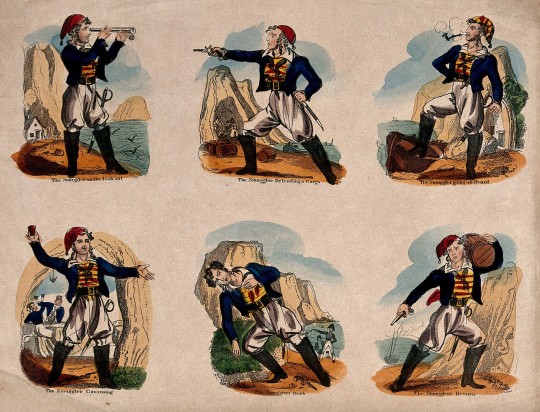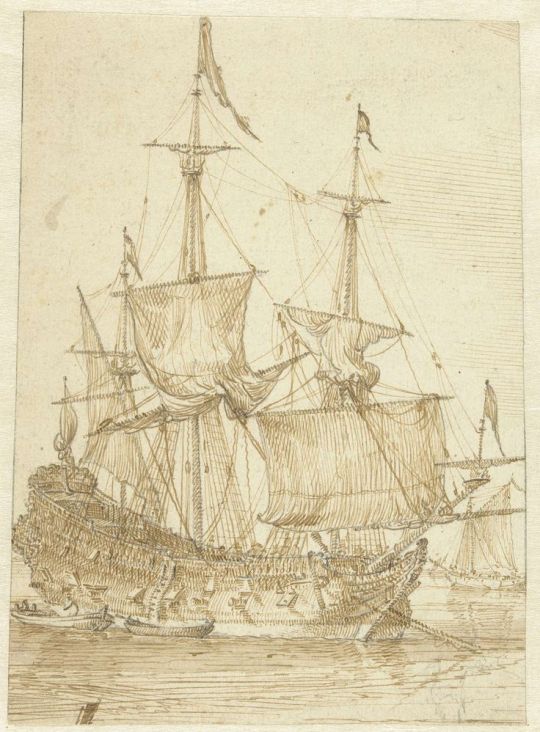Text

A Ship on the High Seas Caught by a Squall, Known as ‘The Gust’, by Willem van de Velde the Younger (1633–1707)
107 notes
·
View notes
Text

The Good Ship Constellation- U.S.S. Constellation bring relief supplies for the victims of the Irish famine of 1880, by Tom Freeman (1952-)
72 notes
·
View notes
Text
61 notes
·
View notes
Text
Hard-up
Hard is another often used nautical term. To put the helm hard over is to put it as far as it will go in that direction. Hard and fast describes a vessel firmly aground and unable to make progress and has come ashore to mean rigid. ‘Hard up in a clinch and no knife to cut the seizing’, the term from which hard up derives, was a sailor’s way of saying he had been overtaken by misfortune and saw no way of getting clear of it. Shore-side, the term means in need or you have very little money.
78 notes
·
View notes
Text

Naval flintlock Duck Foot Pistol with Silver Inlay by Bunney of London, 1770-1780
These types of pistols were designed for Naval officers during the 18th century when a sailor's life was very hard and far from happy. These fearsome pistols were meant to deter mutiny which history tells was a far too common event at the time. Eventually, in the late 1790s, the entire British Fleet committed mutiny at Spithead bringing sweeping changes to the daily life of a British sailor aboard a ship.
167 notes
·
View notes
Text

'A smuggler shown at different stages and points of his chosen profession', 19th century coloured etching (Wellcome Collection).
Odd choice to depict "The Smuggler's Death" at bottom centre followed by "The Smuggler's Return," when reading left to right. No matter what direction you go, death is but a temporary obstacle in his career.
123 notes
·
View notes
Text

The fire on the Wharves of Algiers, shortly after the commencement of the Bombardment by the Anglo-Dutch Fleet, 27 August 1816, by Nicolaas Baur, 1816 - 1820
94 notes
·
View notes
Text

Dutch Warship, by anonymous, 1670 - 1726
66 notes
·
View notes
Text

The “Gouden Leeuw “ and “Zeven Provinciën” in front of Den Oever , Wieringen around 1670, by Jan de Quelery (1957-)
122 notes
·
View notes
Text

Ship, by anonymous, 1600 - 1699
210 notes
·
View notes
Note
What's the proper nautical pronunciation of the word "lieutenant"? That is, is it pronounced "leff-ten-ant" or "loo-ten-ant"? Or does it depend only on whether you're using a recieved pronunciation or not?
Hi,
in British English it is Leftenant and in American it is Lootenant and means a placeholder for a superior, during their absence.
Originally, the word consisted of two Latin terms, "locum" meaning "in place of" and "teneris" meaning "to hold", which together referred to anyone who held "in place of" another person. Over time, the word "locum" evolved into the French word "lieu", which is pronounced exactly as it is written in French and means lieu tenant, from liu + tenant holding. It is possible that when the English heard the French pronounce the compound word lieutenant, they recognised a "v" or "f" between the first and second syllable.
Others believe that it was deliberately pronounced with an f by the British to show the French that they didn't like them, but there is also the theory that if you pronounce it as lootenant then you could mean the British slang word loo for toilet and thus denigrate the officer.
We don't know exactly what it is, there are many variations. But most English-speaking countries, with the exception of the United States, still pronounce the word as if it contained an "f".
88 notes
·
View notes
Text
My dears tomorrow i finally have a day off and can take care of new things for here. I'm sorry about how things are going at the moment, I already have the feeling that everything here is sinking towards Davy Jones's Locker, but I'm trying to revitalise everything.
68 notes
·
View notes
Text

Captain Aubrey with 1.Lt. Pullings and 2.nd. Lt. Mowett
#master and commander#the boys#all in dressed uniform#age of sail movies and series#pullings tuesday
322 notes
·
View notes
Text
Different Rating of a Ship
While the admiralty classified the ships according to their size and number of cannons in rates. Starting in 1760 a group of men, begann to rate the ships in a different way. It was Llyods of London with its Register of Ships. It rates the overall quality of a vessel alphanumerically according to her seaworthiness. In the original list, which started 1764, ships were designated by the letters A, E, I, O, U, which referred to a vessel’s hulls, while the letters G, M, and B (good, middling, and bad ) rated the vessel’s equipment. A rating of AG denoted a first class ship with god outfitting, while UB described the lowest class of a ship with bad outfitting.

Today, yes the list still excists, letters denote the condition of the hull, while fittings (anchors, rigging and so on) are graded numerically.
As discribed in the Register : The character A denotes new ships or ships renewed or restored. The stores of vessels are designated by the figures 1 and 2; 1 signifying that the vessel is well and sufficiently found.
But why all this ? and did that also apply to warships ?
The register served only to give merchants and insurers an idea of the condition of the ships they chartered or insured. It also gave them an insight into who the owner was or which company owned the ship. Warships were not rated, the Admiralty did not tolerate this, they alone were responsible for their ships.
48 notes
·
View notes
Text



Cannon swab bucket, taken from the British Schooner "DOMINICA" August 5th 1813
Beside each muzzle loading ship's cannon there always stood a large bucket of water. Immediately after the cannon was fired a gunner was required to "swab out" the interior of the cannon barrel with a very wet mop to extinguish any remaining sparks from the previous discharge. Failure to do so could result in the cannon immediately exploding once a fresh powder charge was introduced into the muzzle.
These Swab Buckets always used Brass/Copper bands to prevent the possibility of a spark being unintentionally generated had they used steel that a true hazard during naval warfare.
58 notes
·
View notes
Text

A scrimshawed shoe horn, made and owned by Wm Young, 19th century
31 notes
·
View notes